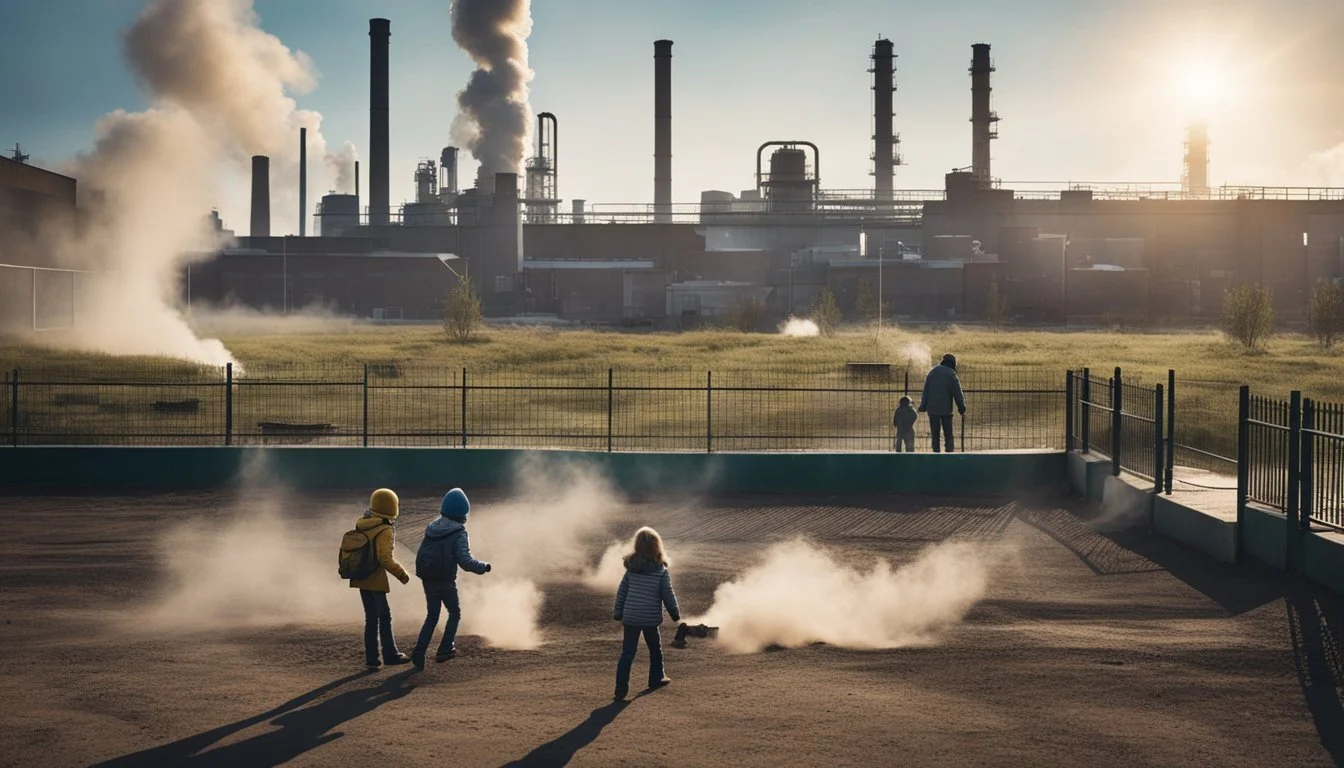Inquirer Investigation Reveals Toxic Health Risks in Philadelphia Schools
The Philadelphia Inquirer's "Toxic City" investigation shed light on alarming environmental hazards in Philadelphia schools. Reporters uncovered over 9,000 environmental problems, including mold, asbestos, and lead paint, through innovative reporting methods and community-based testing. The investigation exposed unhealthy conditions affecting children's health and safety, leading to significant changes in how schools address these hazards.
The series combined traditional and modern reporting techniques to uncover the extent of contamination in Philadelphia's educational institutions. Journalists enlisted teachers to help gather data, creating a comprehensive picture of the environmental risks students face daily. This collaborative approach allowed for a more thorough examination of the issues plaguing city schools.
"Toxic City" had a substantial impact, prompting action from local authorities and school administrators. The investigation's findings resulted in increased inspections and improvements in how schools handle environmental hazards. The series was recognized as a finalist for the 2019 Pulitzer Prize, highlighting the importance of environmental reporting in protecting public health.
The Inquirer's Investigative Team
The dedicated journalists behind "Toxic City" combined innovative techniques with traditional reporting to uncover environmental hazards in Philadelphia schools. Their groundbreaking work earned national recognition and sparked important changes.
Reporters of 'Toxic City': Profiles
Barbara Laker, Wendy Ruderman, and Dylan Purcell formed the core reporting team for "Toxic City". Laker and Ruderman, both Pulitzer Prize winners, brought extensive investigative experience to the project. Purcell contributed crucial data analysis skills.
Jessica Griffin provided compelling visual storytelling as the team's photographer. Her images powerfully illustrated the environmental issues plaguing Philadelphia schools.
The reporters' diverse backgrounds and complementary skills allowed them to approach the investigation from multiple angles. They conducted in-depth interviews, analyzed complex datasets, and employed innovative community-based testing methods.
Behind the Scenes: Research and Challenges
The "Toxic City" investigation spanned nine months and uncovered over 9,000 environmental problems in Philadelphia public schools. The team faced significant hurdles in obtaining information from reluctant officials.
To overcome these obstacles, the reporters enlisted teachers to help gather data. This community-based approach allowed them to collect samples and document conditions inside school buildings.
The investigation required meticulous fact-checking and data analysis. The team worked tirelessly to ensure accuracy while presenting their findings in a clear, compelling manner.
Their efforts paid off. "Toxic City" won the $5,000 Gannett Award for Innovation in Watchdog Journalism and was named a finalist for the Pulitzer Prize in Local Reporting.
Scope of 'Toxic City' Investigation
The Inquirer's "Toxic City" investigation examined widespread environmental hazards in Philadelphia schools. Reporters utilized innovative testing methods and data analysis to uncover thousands of problems putting children's health at risk.
Identifying Environmental Hazards in Schools
Reporters focused on three major hazards: lead paint, asbestos, and mold. They found over 9,000 environmental issues across Philadelphia public schools. Lead paint posed risks of developmental delays and learning difficulties. Damaged asbestos materials threatened to release harmful fibers into the air.
Mold growth indicated moisture problems and potential respiratory issues. The investigation revealed these hazards were particularly prevalent in schools serving low-income and minority students.
Scientific Testing and Data Analysis Methods
The Inquirer team employed rigorous scientific testing protocols. They collected dust wipe samples to detect lead contamination on surfaces. Air quality tests measured airborne asbestos fibers. Moisture meters and visual inspections identified areas of mold growth.
Reporters partnered with teachers to gather data from classrooms citywide. This community-based approach expanded the investigation's reach. The team analyzed thousands of maintenance records and work orders. They cross-referenced this data with demographic information to reveal disparities in environmental conditions between schools.
Findings and Impacts on Public Health
The "Toxic City" investigation uncovered widespread environmental hazards in Philadelphia schools, posing serious risks to students' health and well-being. These findings highlighted the urgent need for remediation and improved safety measures.
Lead Exposure and Its Dangers
Lead contamination emerged as a primary concern in Philadelphia schools. The investigation revealed peeling lead paint and lead-contaminated dust in numerous classrooms and common areas. Exposure to lead can cause severe developmental issues in children, affecting cognitive function and behavior.
High-risk areas included older school buildings with deteriorating paint and plumbing systems. Even low levels of lead exposure can result in learning difficulties, reduced IQ, and attention problems.
The report prompted increased testing and remediation efforts. Schools implemented more stringent cleaning protocols and lead-safe practices to minimize exposure risks.
Asbestos Risks and Schools
Asbestos fibers posed another significant health hazard in many Philadelphia schools. The "Toxic City" investigation identified damaged asbestos-containing materials in various buildings, putting students and staff at risk.
Asbestos exposure can lead to serious respiratory issues and lung diseases, including mesothelioma. The investigation found instances of crumbling ceiling tiles and deteriorating insulation releasing harmful fibers into the air.
These findings led to improved asbestos management plans and increased removal efforts in affected schools. Regular inspections and air quality monitoring became more prevalent to ensure student safety.
Mold and Air Quality Concerns
The investigation also uncovered widespread mold problems and poor air quality in numerous schools. Leaky roofs, inadequate ventilation, and high humidity levels contributed to mold growth in classrooms and other areas.
Mold exposure can trigger allergic reactions, respiratory issues, and exacerbate asthma symptoms. The report highlighted the need for better moisture control and HVAC system maintenance.
In response, schools implemented more rigorous cleaning protocols and improved ventilation systems. Some buildings underwent extensive renovations to address persistent moisture problems and improve overall air quality.
Reporting Outcomes and Public Policy
The Inquirer's "Toxic City" investigation spurred significant policy changes and infrastructure reforms in Philadelphia schools. Government officials responded with new initiatives to address environmental hazards and improve maintenance practices.
Policy Changes and Government Response
Gov. Tom Wolf allocated $15.7 million in emergency funding to address unsafe conditions in Philadelphia schools. The School District of Philadelphia implemented stricter lead testing protocols for drinking water. City Council passed legislation requiring schools to maintain public logs of environmental hazards.
The investigation led to increased fines for contractors violating dust control regulations during construction near schools. The Department of Licenses and Inspections conducted over 130 work site inspections in affected neighborhoods.
Infrastructure and Maintenance Reforms
School officials accelerated asbestos removal projects and lead paint remediation efforts. The district hired additional maintenance staff and environmental inspectors to address backlogs of repairs.
A new online system was implemented to track and prioritize maintenance requests. Schools began conducting more frequent lead dust wipe testing and mold inspections. Water filtration systems were installed in schools with elevated lead levels.
The district also improved transparency by publishing detailed environmental testing results and maintenance logs on its website for public access.
Community and Stakeholder Reaction
The "Toxic City" investigation sparked widespread concern and action among Philadelphia's school community. Parents, teachers, and students rallied together to demand safer learning environments and push for meaningful changes.
Parental Concerns and Mobilization
Parents expressed shock and anger upon learning about the environmental hazards in their children's schools. Many formed grassroots organizations to advocate for immediate remediation efforts. These groups organized protests, attended school board meetings, and launched social media campaigns to raise awareness.
Some parents took matters into their own hands, conducting independent testing and sharing results with school officials. Others partnered with local environmental groups to educate fellow community members about the risks of lead, asbestos, and mold exposure.
Teachers' Perspectives and Union Response
Teachers voiced alarm over the unsafe conditions they and their students faced daily. Many reported health issues they believed were linked to poor air quality and other environmental problems in their classrooms.
The Philadelphia Federation of Teachers took a strong stance, demanding:
Comprehensive environmental testing in all schools
Immediate removal of hazardous materials
Regular updates on remediation progress
Improved maintenance protocols
Union representatives worked closely with district officials to develop action plans for addressing the most critical issues identified in the investigation.
Students' Stories and Community Involvement
Students played a crucial role in bringing attention to the environmental problems in their schools. Many shared personal stories of health issues they experienced, from asthma attacks to skin rashes.
Youth-led initiatives emerged:
Student-run social media campaigns
Letter-writing drives to local officials
School walkouts to protest inaction
Community organizations stepped up to support these efforts, offering resources and expertise. Local businesses and volunteers helped with cleanup efforts in some of the most affected schools.
Media Recognition and Journalism Awards
The Inquirer's "Toxic City" investigation garnered significant acclaim from prestigious journalism organizations, highlighting its impact on environmental reporting and public awareness. The series received multiple awards for its in-depth coverage of environmental hazards in Philadelphia schools.
Awards Received and Their Significance
The "Toxic City" series won the Frank A. Blethen Award for Local Accountability Reporting, presented by the American Society of News Editors and Associated Press Managing Editors. This award recognizes outstanding investigative journalism that holds local institutions accountable.
The investigation was also named a finalist for the Pulitzer Prize, one of journalism's highest honors. This recognition underscores the series' importance and far-reaching impact on public health and education.
The Society of Environmental Journalists awarded the "Toxic City" team first place in the Kevin Carmody Award for outstanding in-depth reporting in large media markets. This accolade highlights the series' contribution to environmental journalism.
Contributions to Investigative Reporting
The "Toxic City" investigation demonstrated innovative reporting techniques by enlisting teachers to help collect data on environmental hazards in schools. This community-based approach uncovered over 9,000 environmental problems, including mold, asbestos, and lead paint.
The series' impact extended beyond reporting, leading to tangible changes in how Philadelphia schools address environmental hazards. It prompted increased inspections and remediation efforts in affected schools.
The investigation's success in combining traditional reporting methods with community engagement set a new standard for investigative journalism. It showcased the power of collaborative reporting in uncovering systemic issues and driving meaningful change.
Long-Term Implications and Continuing Coverage
The Philadelphia Inquirer's "Toxic City" investigation sparked significant changes in environmental safety practices within Philadelphia schools. This groundbreaking series exposed numerous hazards, including lead paint, asbestos, and mold, affecting thousands of students.
The impact of this reporting extended beyond immediate reforms. It prompted ongoing scrutiny of environmental conditions in educational facilities. The Inquirer's work set a new standard for investigative journalism in this field.
Other news organizations took notice. The "Toxic City" series became a model for similar investigations across the country. It demonstrated the power of data-driven reporting combined with community engagement.
The investigation's innovative approach earned recognition from prestigious journalism organizations. The Inquirer received the Gannett Award for Innovation in Watchdog Journalism from Investigative Reporters and Editors.
This accolade highlighted the series' unique data collection methods and compelling storytelling. It also emphasized the importance of sustained coverage on environmental issues affecting vulnerable populations.
The "Toxic City" investigation continues to influence policy discussions. It has become a reference point for debates on school infrastructure, public health, and environmental justice.
Researchers and policymakers now cite the series in their work. It has contributed to a broader understanding of the long-term effects of environmental hazards on child development and academic performance.






